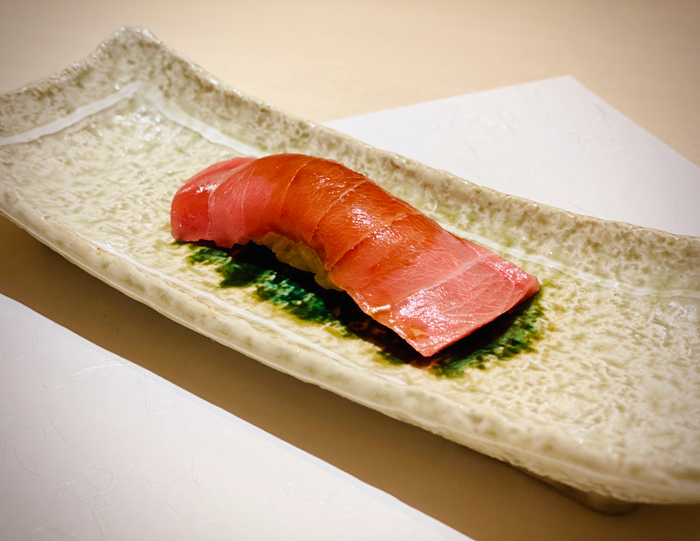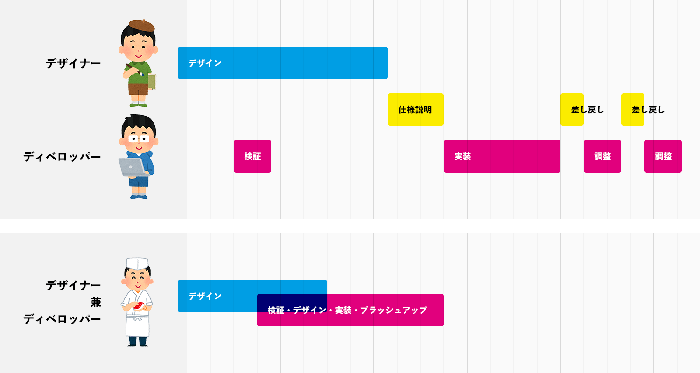Web and Sushi

Takashi Kamata
spfdesign Inc.
Nice to meet you.
I'm Takashi Kamata. I'm Head of Design / Chief Art Director / Web Designer at Dentsu Craft Tokyo, which started in early 2019, and I also run a web production company called spfdesign Inc.
I've been making websites for about 22 years now, and I also love sushi.
When you've been building websites for this long, your approach naturally evolves, and I'm sure everyone's methods differ greatly.
This time, I'd like to write about how I've been building websites over the past few years, drawing parallels with making sushi.
The Homepage Guy Era
Back when I was still a student and just starting to get interested in design, I'd copy cool flyers I saw around town, design my own stuff, make original T-shirts using iron-on transfer paper, and then sell them to friends and younger classmates.
Around that time, I heard a piece of information—which could be seen as advice from victims of T-shirt pushy sales to avoid further victimization—saying, "If you use this thing called the Internet, you might be able to sell T-shirts to people all over the world." That was my first encounter with the Internet, when I bought a book with a title like 'Build a Homepage in a Week'. Pee-hyororo~ bwoon bwoon bwoon.
Breathing fire, I opened the book determined to make this cool homepage thing. But it didn't cover design at all—just technical stuff. It was like a sushi apprentice having to learn everything except "making sushi" before they could even touch a piece of fish.
Pretending to understand things like URLs and servers, I struggled through it all. When my own image finally appeared in a browser across the internet for the first time, I remember trembling with excitement, unable to even put into words the sheer, unfathomable vastness of this ocean called the internet. It was like placing sashimi on top of rice packed into a barrel shape and unexpectedly finding it looked surprisingly like sushi, making you grin without even realizing it.
Amidst all this, I inevitably developed a style where I simultaneously experienced both the design and technical aspects of websites through repeated homepage creation—launching that incredibly tacky first homepage ("Welcome to Takashi's Home Page!"), then quickly making the next one (complete with a visitor counter).
Crossing Professional Boundaries
Time passed, and when I began working as a professional web creator, I was forced to choose: designer or developer? It was like being told, "Do you want to make sushi or cook the rice? Pick one."
That's the professional world for you. Though bewildered by the existence of specialists in each field, I chose to pursue a career as a designer. This was the heyday of Flash. For younger readers who might not know what Flash is, it essentially meant creating websites with excessively bouncy, jiggly animations.
When you try to make a website like that, you naturally want to design the bouncy-jumpy effect. Sadly, though, it's the developer's job to make things bounce. "That bounce isn't quite right—I want it to bounce more like this." "Like this?" "No, that's more like a flop, not a bounce." And before you know it, I'd be saying, "Let me handle it!" and diving into the bouncing work myself. To make sushi I was satisfied with, I needed the rice cooked to my ideal state.
This is how we ended up reverting a once-specialized structure back to the style from the old homepage guy days, where one person handled both the design and technical aspects. Once you remove the boundary between design and development, other elements start crossing over like dominoes.
I started caring about things like whether the domain structure looked more stylish, the organization of data through file and directory names, the use of full-width and half-width characters, and even the backend database design. It didn't stop there; I began thinking about more efficient ways to proceed with production and how to organize information.
If the goal is to serve customers the perfect piece of sushi—made from flawlessly prepared fish, perfectly cooked rice, and masterfully shaped with precise temperature, pressure, and proportions, all served at the ideal moment—then you'd want to source the fish yourself, sharpen your knives to perfection, adjust the rice cooking to the season, obsess over the counter and chair heights, and even consider the view from the counter seat. I don't know for sure, but I imagine that's how it is.
A delicious piece of sushi incorporates an immense amount of "this and that before the actual shaping" into its very core. In other words, all that "this and that" collectively constitutes sushi-making.
In a similar vein, while calling myself a web designer, I increasingly find myself stepping right into established domains like direction and development. Amidst this, over the last two or three years, I've become strongly convinced that there are definite advantages to ultra-small, self-contained teams.
Of course, there are also cases where it's better (or necessary) to have specialists gathered for each specific area, and I do participate in projects structured that way.

Why is the ultra-small, self-contained team model good?
Among the many roles in web production, I'll list five benefits of handling both design and development—my primary approach.
Benefit #1
You can visualize the final look of the desired expression while simultaneously figuring out how to implement it. It's like seeing a fish at the market and immediately picturing it on the plate, calculating the prep work and time needed right then. This lets you instantly decide if you can serve it to a customer with a 8 PM reservation.
Benefit #2
I can create mockups quickly during the planning phase. Depending on the project type, developers aren't usually present during planning—is that your experience too?
During Dentsu Craft Tokyo's preparatory period, while developing the logo, I envisioned how motion would be applied to the logo concepts. At the first meeting after the logo was finalized, I brought the image below. We had completed the motion logo long before the website design, let alone the wireframes, existed. It's like not just imagining which fish would be best for clear soup, but actually preparing it, tasting it, and making decisions based on that experience.
Benefit #3
The basic workflow in web production involves moving to implementation only after the design is complete. Designers must meticulously design each page, define specifications, and communicate these to developers. Accurately conveying all this requires an enormous amount of time. Furthermore, nowadays, websites are viewed on more devices than just PCs—smartphones, tablets, and others—meaning the design workload has increased to two or three times what it used to be. Naturally, the time needed for communication increases proportionally.
However, when one person handles both design and development, all specifications exist simultaneously in the designer's mind and the developer's mind. The time required for communication is zero seconds. It's like making sushi without ever having to fillet the fish. I realize the sushi analogy might be a stretch.
Benefit #4
When designers and developers are specialized roles, meticulous designers tend to strive for extremely detailed specifications. However, when actually building the product, unforeseen problems frequently arise. This inevitably leads to unexpected rework time squeezing the schedule, and feelings of guilt can stifle productivity.
On the other hand, combining design and development allows for specification refinement through iterative implementation and testing, significantly reducing unexpected rework. Think of it like a sushi restaurant that never says, "Sorry, it wasn't very tasty today—please come back tomorrow."
Benefit #5
As mentioned earlier, designers need to create designs optimized for various devices like PCs, smartphones, and tablets. However, when you also handle development, you can essentially say, "We'll let the implementation stand in for the design." After getting approval for the PC design and a basic smartphone design, you can then refine the look on smartphones and tablets as you implement them. This means implementation progresses quite a bit even during the design phase, which is incredibly efficient. It's like serving the sushi the moment you show the menu!

So, what do you think?
I hope you can see the benefits this approach offers.
Even as web development grows more complex and specialization becomes increasingly fragmented, I hope to keep exploring as broadly as possible—and of course, as deeply as possible—while still gripping my mouse tomorrow.
No need to use the sushi analogy, and even though it's been falling apart all along, thank you for reading to the end. I know nothing about making sushi, so if you want accurate information, ask a web designer who also happens to be a sushi chef.
Dentsu Craft Tokyo is a "Creative House" where conceptual power, production power, and execution power coexist, transcending organizational, positional, and title barriers. If you're seeking a place where you can keep creating freely, unrestricted by the field defined by the title on your business card and crossing professional boundaries, please get in touch.
Was this article helpful?
Newsletter registration is here
We select and publish important news every day
For inquiries about this article
Back Numbers
Author

Takashi Kamata
spfdesign Inc.
Born in Kobe in 1979. Graduated from Kobe National College of Technology, Department of Urban Engineering. Founded spfdesign Inc. in 2006. Handles production of brand sites, promotional sites, and e-commerce sites for various companies. Notable works include Toraya, UNIQLO CALENDAR, and Tada-ya. Represented Japan at the 2007 Cannes Lions International Festival of Creativity Young Creatives competition, winning Silver. Numerous domestic and international awards, including Cannes Lions, One Show, Clio Awards, New York ADC, AdFest, London International Awards, D&AD, New York Festival, Good Design Award, and TIAA.

